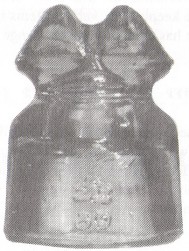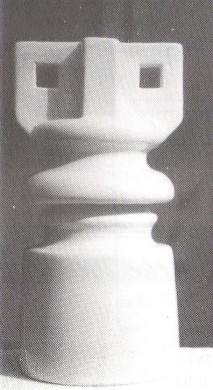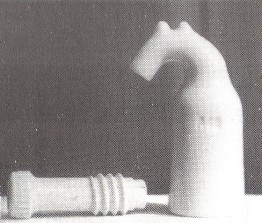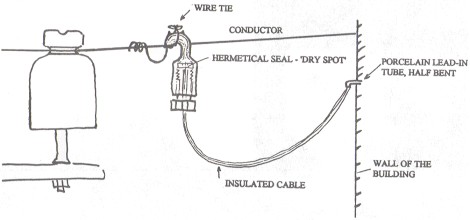Foreign Insulators
by Marilyn Albers
Reprinted from "Crown Jewels of the Wire", December 1992, page 26
NEW CD!
Introducing CD 590.5 in pretty lime green from Russia! It's really too bad we
didn't see this one in time to include it in GLASS INSULATORS FROM OUTSIDE NORTH
AMERICA (Second Revision), but it's just arrived here in the States with a
friend
of Carol McDougald's. It measures 2-7/8" wide at the base and stands 3-7/8" tall. Embossed on the
front is that funny looking 'insulator' logo
with two legs that we see on so many Russian insulators (Carol calls it a space
ship!). It carries a date of '89', which explains why the insulator looks so
new. The back side of the insulator has the marking 'HC18A1'. The letters 'HC'
are the Russian equivalent of our 'NS'. Don Fiene (Knoxville, TN) recently came
back from Russia with some large glass insulators embossed with the same logo
and an even more recent date of 1991 (See October, '92 CROWN JEWELS) We don't
know anything about this company or where in Russia it is located, but it is
obviously an active insulator manufacturer. Next time you go back, Don, save
some time to track down the factory and see what you can learn.

CD 590.5 |

Russian logo found on the skirt of new CD 590.5 |
SUPER SPOOK
This large fuse insulator was found by Caleb Thimell down in Colombia shortly
before he finished his assignment there and came back to the states. It is 7-3/4" tall and weighs a hefty 3-1/2
lbs. As you can see from the photo, it
has several unusual features. Because of the two holes, this type is usually
referred to as the "spook", but in this case, the eyes are square and
they peer out from either side of a very large nose. Caleb, it looks like you
may have found an owl instead, and I don't know that owls have U-Numbers, but
maybe we better scratch around and find one for this bird! It is really a super
insulator.
It came with a large metal pin securely (and I mean securely) cemented inside
the pin hole. It took 4 months of patience and a lot of Muriatic acid to set it
free. There is no marking on the insulator, which is unusual for one this size.
We usually find unmarked pieces among those about 4" in height or under.
Colombia imported several porcelain styles from HERMSDORF of Germany as well as
from an Italian insulator manufacturer known as RICHARD GINORI. The insulator is
made of the same fine quality porcelain as some of the other pieces we have seen
from these companies.

"Caleb's Owl" |

Steinbuch Bushing |
AND A HORSE IS A HORSE, OF COURSE
I was delighted when I opened one of my 'trade boxes' from Frantisek Danek of
Obratan, Czechoslovakia and found this little porcelain insulator among the
pieces he sent. When the two parts are screwed together, the insulator measures
4-1/8" in height. It really does look like a horse, and without his
explanation I'd never have guessed how it was meant to be used. He calls it a
Steinbuch bushing, presumably named for the person who patented the design. The
incuse mark 'A48', which appears on the skirt, gives us no indication of either
the maker or user. When the insulator first arrived, it still had a piece of
wire in place, and I have kept it that way. The threaded base 'plug' is hollow
so the wire can pass through it. This is Frantisek's explanation of the
insulator's use:
Steinbuch bushings were used instead of dry-spot insulators, such as U-1941
(1935, 1938 etc.). Their use was much cheaper and more flexible. According to
British practice, in order to make a telephone extension, a dry-spot insulator
was used. Its purpose was to prevent the penetration of humidity into the
insulated telephone extension cable. When adding a further extension to the
line, it was necessary to replace the standard PTT insulator with a dry spot
insulator. A Steinbuch bushing was much easier to use. It could be used
anywhere, by simply hooking it on the wire, fastening it, and connecting the
cable. See the sketch enclosed
Thanks, Frantisek, for sharing that with us.

|
